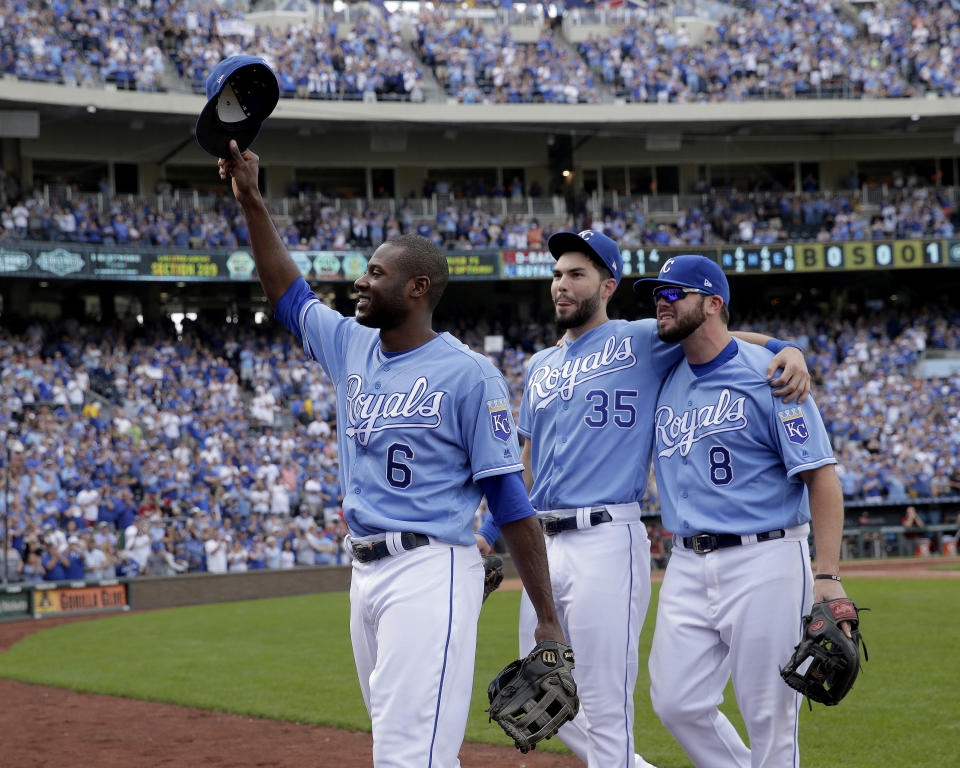Eric Hosmer, Jake Arrieta among players to receive qualifying offers

As of 5 p.m. ET on Monday, Major League Baseball free agency is underway. There haven’t been any major signings just yet, but some important decisions have already been made. On Monday, teams determined which of their upcoming free agents deserved qualifying offers.
The qualifying offer system changed during the last collective-bargaining agreement, so things are slightly different this year. The main thing to know is this: Players who received a qualifying offer are able to return to their current team for $17.4 million next year. If a player declines and hits the market, the team will receive draft compensation if that player signs with another club.
The new system is actually fairly in-depth, and we’ll cover that below. Now, though, here are the players who did and did not receive qualifying offers Monday.
Players who received qualifying offers:
• Eric Hosmer, 1B, Kansas City Royals
• Jake Arrieta, SP, Chicago Cubs
• Carlos Santana, DH, Cleveland Indians
• Mike Moustakas, 3B, Royals
• Lorenzo Cain, OF, Royals
• Wade Davis, RP, Cubs
• Alex Cobb, SP, Tampa Bay Rays
• Lance Lynn, SP, St. Louis Cardinals
• Greg Holland, RP, Colorado Rockies
Players who did not receive a qualifying offer:
• Andrew Cashner, SP, Texas Rangers
• Zack Cozart, SS, Cincinnati Reds
• CC Sabathia, SP, New York Yankees
• Logan Morrison, 1B, Rays
In 2015, Colby Rasmus made history by becoming the first player to accept a qualifying offer. He returned to the Houston Astros for $15.8 in 2016. He seemed to start a trend. Last offseason saw Jeremy Hellickson and Neil Walker also accept qualifying offers.
It’s tough to find any players who might accept their qualifying offers this year. The Royals’ players and Arrieta are locks to decline. They’ll all get big multi-year deals on the market. Davis, Holland and Cobb are in that category too.
Tommy John surgery didn’t seem to impact Lynn’s return in 2017. He remained healthy enough to make 33 starts. And while he’s not an elite name, the pitching market is pretty weak. A team that misses out on Arrieta or Yu Darvish could look to Lynn as a backup plan.
Santana is also probably safe to get a multi-year offer in free agency. The only reason for concern is that the value of first basemen and designated hitters plummeted last winter. Santana has never been a high average hitter, but his elite walk rate should get him looks despite his age.
OK, so, what happens if a player on your favorite team declines a qualifying offer? Well, it got really complicated with the new CBA. This is how our own Jeff Passan summed it up last December:
For both those losing and signing players with qualifying offers, the rules separate them into three categories: teams receiving revenue-sharing money (there are 16), teams over the luxury-tax threshold and teams that don’t fall into either category.
If a revenue-sharing payee loses a player it gave a qualifying offer to a contract for $50 million-plus, that team receives a pick right after the first round and for under $50 million after the second. Teams over the luxury tax don’t get a pick until after the fourth round. The rest of the teams are given picks after the second or third rounds. If a team receiving revenue sharing signs a qualifying-offer player, it forfeits a third-round pick. The in-between team gives up a second-round pick and $500,000 in international bonus money. And the team over the luxury tax? Well, it has every reason to be frightened: It surrenders second- and fifth-round picks, plus $1 million in international money. And if it happens to be a team more than $40 million over the threshold, its first-round draft pick automatically falls 10 spots from its original location, too.
Admittedly, the new system makes things a bit convoluted. It all depends on whether the team getting rid of or signing the player pays or receives revenue-sharing money. That’s the exact method in place starting this winter.
For fans who don’t want to get bogged down in the specifics, the main thing to know is this: If a player on your favorite team declines a qualifying offer and signs with another club, your team gets a draft pick back.
The nine players who received qualifying offers Monday now have 10 days to either accept or decline them.
More MLB coverage from Yahoo Sports:
– – – – – – –
Chris Cwik is a writer for Big League Stew on Yahoo Sports. Have a tip? Email him at christophercwik@yahoo.com or follow him on Twitter! Follow @Chris_Cwik


